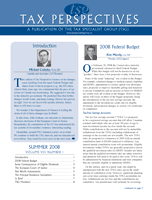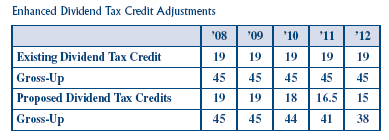
PDF Format
 Issue Contents Issue Contents
 All Issues All Issues
Summer 2008
Volume 8, Number 1
The information in Tax Perspectives is prepared for general interest only. Every effort has been made to ensure that the contents are accurate. However, professional advice should always be obtained before acting and TSG member firms cannot assume any liability for persons who act on the basis of information contained herein without professional advice.
2008 Federal Budget
By Kim Moody, CA, TEP
Moodys LLP Tax Advisors (Calgary)
On February 26, 2008 the Conservative minority government released its third Federal Budget. While this budget will not be known for its tax "goodies", there were a few proposals worthy of discussion.
Some of the usual "tinkering" was evident in the Budget. For example, continued changes to medical expense eligibility and RESPs, adjustments to certain capital cost allowance rates, proposals to improve charitable gifting and donations to private foundations and an increase in limits for SR&ED tax credits were all evident in the Budget. However, this article will focus on three of the bigger proposals, being the introduction of the tax-free savings account, the adjustment to the dividend tax credit rate for eligible dividends, and proposed changes to section 116 certificates of compliance.
Tax-Free Savings Accounts
The tax free savings account ("TFSA") is proposed to be a registered savings account that will allow Canadian resident individuals who are at least 18 years of age to earn investment income tax-free inside the account. While contributions to the account will not be deductible, withdrawals from the TFSA (including withdrawals of earnings in the account) are not taxable. The new TFSA rules are proposed to commence in 2009 with an annual contribution limit of $5,000 (indexed to inflation). Any unused annual contribution room will accumulate. Eligible investments within TFSAs are generally proposed to mirror the qualified investment rules for RRSPs. Readers are likely aware that the qualified investment rules are rather restrictive and attention will need to be paid to this issue. TFSAs will be administered by financial institutions and trust companies that are currently eligible to administer RRSPs.
On the surface, and on a quick read, one might be unimpressed with the new TFSA rules, given the small amount of contribution room. However, significant planning can occur since earnings inside the TFSA accumulate tax free, withdrawals are tax-free and the contributions are cumulative. Tax practitioners will certainly be reviewing these rules with a view to encouraging their clients to utilize them.
Eligible Dividend Rules
As has been the subject of other articles, the introduction of the eligible dividend rules has resulted in significant tax reductions for shareholders receiving dividends that are paid by Canadian public companies and private companies from high-tax corporate profits. Given the announcement of aggressive corporate tax rate reductions in the October 2007 Economic Statement, the 2008 Federal Budget proposes to adjust the dividend tax credit and gross up mechanisms to take into account the underlying corporate tax rate reductions.
This will result in the overall tax rate on eligible dividends increasing from 2010 to 2012. For example, the highest tax rate on eligible dividends for Alberta resident recipients was scheduled to be at 14.55% for 2009 and thereafter. However, that rate is scheduled to be increased to 19.29% in 2012 (by increasing the rate each year starting in 2010). Accordingly, shareholders and their tax advisors will need to consider such tax rate adjustments carefully and plan accordingly.

Gains of Non-Residents
A third significant announcement made by the Government in the 2008 Federal Budget was the introduction of amendments to simplify the procedures for non-residents who sell certain Canadian property (typically shares of private Canadian corporations). These changes intend to relieve certain administrative burdens in the process of obtaining clearance from paying Canadian income tax where the gain would be exempt by an international tax treaty.
As many readers know, one of the biggest problems for non-residents is the process of getting an exemption from Canadian tax when selling an asset that is excluded from Canadian tax by the expressed provisions of a tax treaty. Under current law, if the purchaser does not withhold tax on the sale of certain "taxable Canadian property", even if the property is treaty exempt, then the liability for any tax is assumed by the purchaser. If the purchaser obtains a "certificate of compliance", the purchaser's risk is relieved. However, it has been taking an unreasonably long time lately for the CRA to process certificates of compliance, which has been causing problems in closing transactions. The proposals introduced will streamline and simplify the rules.
|